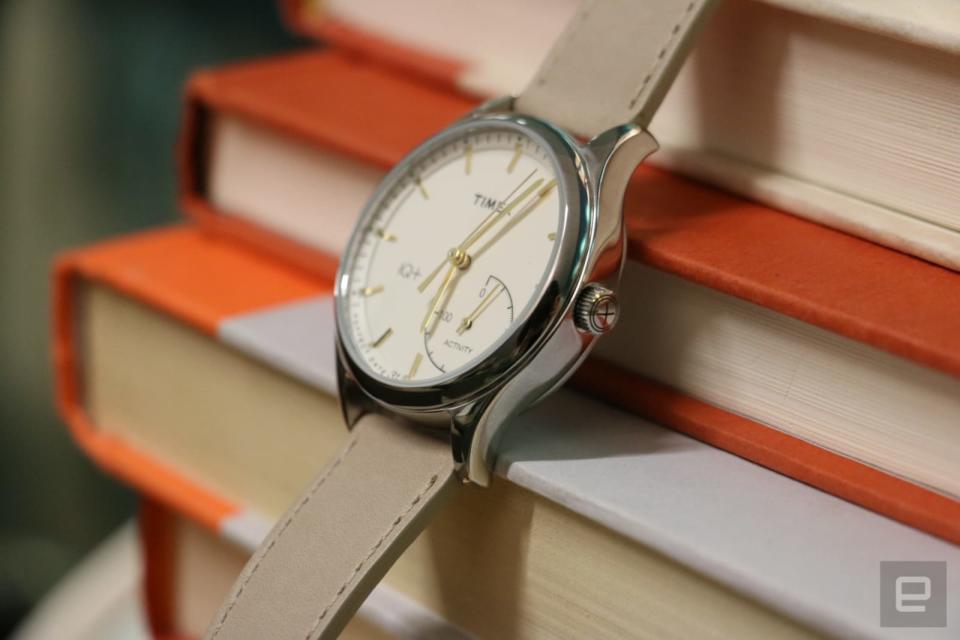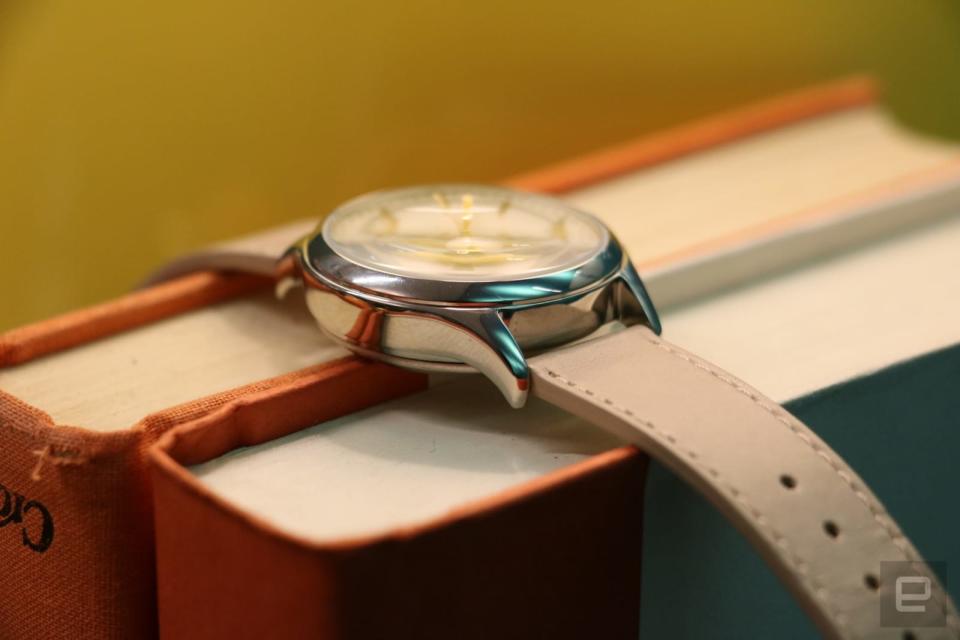The Timex IQ+ Move is a glorified (but very pretty) fitness tracker
You can't tell just by looking at it, but this watch logs your steps, distance, calories and sleep.

Fitness trackers and smartwatches have an image problem. Most of them are bulky or bland-looking, while some are borderline ostentatious. Plus, not everyone wants to ditch her Rolex or Omega for a device with a lit-up face that buzzes every five minutes. So companies have been trying to camouflage their smartwatches by embedding them in traditional, analog timepieces. Timex is proving it can appeal to old-timers with its second analog-tracker hybrid, which has a simpler design and is cheaper than its predecessor. The IQ+ Move comes in men's and women's sizes and designs for $150, and I've been wearing one for about a day. And, despite my misgivings about its scarcity of features, I've been won over by its classic design and excellent build.
Watch purists like me will appreciate the Move's conventional good looks. This thing actually looks like a traditional timepiece, and if no one told you, you wouldn't know it had some smarts. The taupe-colored model I tried is classically pretty, with a dainty 36mm glass-and-metal-alloy case that has a polished sheen. Plus, I loved the slightly intoxicating scent of the genuine-leather 18mm band.
That leather band isn't waterproof, unlike the case, which can withstand submersion in up to 50 meters of water. You can swap it out for a silicone one, which is included with the women's versions.
I was most impressed by how thin its case is. I've always disliked the tall, chunky cases on other smartwatches, but understood that size was a tradeoff to house all the components that make these watches smart. So it was a treat to find that the Move's module is barely noticeable, and its case is actually slightly thinner compared to the company's other fully analog offerings.

Other Swiss brands such as Frederique Constant and Mondain have adopted the third-party MotionX Horological platform for turning analog watches into hybrid smartwatches. But because I haven't seen those two company's products in real life, I can't vouch for how sleek they are in person. The Guess Connected, which is made in partnership with Martian Watches, certainly has a heftier case. Timex, however, developed its own module that it calls the IQ+, which gives it more control over how its devices look and perform. The Move is the first of a series of products with this kind of functionality.
The IQ+ system offers some very basic features, and that might explain why it's thinner than most connected watches. It has an accelerometer that helps it track your steps and distance traveled, and a Bluetooth radio that transmits this information to your iOS or Android device. With the companion app, Timex tracks your calories burned and sleep quality, bringing the total number of monitored metrics to four. In the time that I've had my Move, I've walked an estimated 2.5 to 3 miles (based on Google Map's distance calculations). The app says I've traveled 3.38 miles. That's quite a big difference, but I didn't consider the steps I took at home or in the office, so this isn't the best way to test the Move's accuracy.

I also wore the Move to bed, since it's supposed to automatically track my sleep. Unfortunately, this didn't happen for me, and I awoke to find that no sleep metrics were recorded. It's still not clear if the issue is a fluke or if there's a setting buried in the app that I need to activate (Timex is investigating my problem), but the feature at least appeared to work in a recent demo with company reps present.
That's one of my biggest issues with the Move: Too many things touted as "automatic" aren't actually so. My data is supposed to automatically sync with my phone four times a day, but I realized it wasn't doing that, and I had to manually sync it by holding down the dial for three seconds until I heard a triple beep. Later, as I was exploring the app's settings, I realized that I had to enable auto sync and pick the four precise times of day I wanted data transfer to happen. That's something that should be preset in the app without requiring an opt-in. But it's an easy problem to fix. Timex has already addressed a bunch of customer concerns about previous iterations by revamping its software, making it easier to navigate and use, so an issue like this could potentially be solved very quickly.

Without your phone, you can still monitor your day's progress by glancing at the subdial on the Move's face. You can choose to show your steps or distance progress on the second ring and then set the second hand to always show the other metric. You can also have the second hand point at the current date instead.
The Move doesn't do much else, really. You can set alarms and countdown timers through your phone, but other features I've come to expect, such as call and text alerts, are missing. It has a nice blue backlight that comes on whenever you push on the dial. This takes me back to my childhood, when I would fiddle with my Casio Baby G under my blanket at night. In fact, all it takes is glancing down at the Move on my wrist to transport me back to the days when I wore watches that did nothing but tell time. And that makes me appreciate the device's conventional aesthetic even more.
Overall, the IQ+ Move is one of the best options in the connected-analog-watch space. It is a good alternative to the Withings Activite Steel, and looks more like a timepiece than most devices on the market. I appreciate the availability of sizes for men (41mm face, 20mm bands) and women (36mm face, 18mm band) and the variety of truly gorgeous designs for both genders as well. But folks who are more serious about tracking their fitness might need something that's more full-featured and accurate. The Move is well-suited for someone who prizes good quality and design, and is happy to keep it basic.






































































































